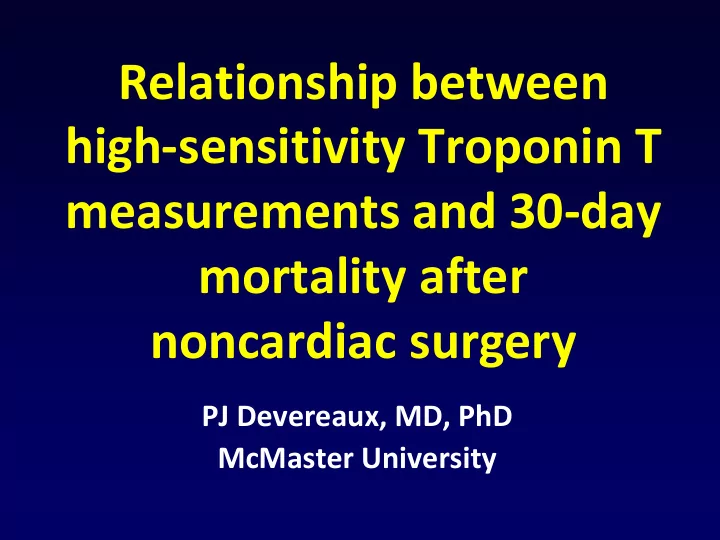

Relationship between high-sensitivity Troponin T measurements and 30-day mortality after noncardiac surgery PJ Devereaux, MD, PhD McMaster University
Background • >5 Million Americans >45 yrs undergo in-patient noncardiac surgery annually and 1.3% die in-hospital – cardiac complications are leading cause • Myocardial injury after noncardiac surgery (MINS) is – defined as myocardial injury caused by ischemia that occurs during or within 30 days after surgery and is independently associated with mortality • Diagnostic criteria for MINS, based on non-high sensitivity Troponin T assay, have been identified • FDA recently approved usage of high-sensitivity Troponin T (hsTnT) assay, and globally many hospitals are using high- sensitivity troponin assays • Little is known about relationship between perioperative hsTnT measurements and 30-day mortality and MINS
VISION design and methods • Prospective, international, cohort study • Eligibility criteria – >45 yrs underwent in-patient noncardiac surgery • Representative sample • Participating countries (23 centres in 13 countries) – North and South America, Europe, Asia, Africa, Australia • Patients had hsTnT measurements 6-12 hours after surgery and daily for 3 days – 40.4% had preoperative hsTnT measurement
Analytic approach • Iterative process (Cox proportional hazards models) exploring potential hsTnT thresholds to determine if there were hsTnT thresholds that independently altered patients’ risk of 30 -day mortality and had aHR ≥3.0 and risk of 30-day mortality ≥3.0% • To determine diagnostic criteria for MINS – Cox proportional hazards model to ascertain if postoperative hsTnT elevations required an ischemic feature (e.g., ischemic symptom, ECG finding) to impact 30-day mortality
Results • Among 21,842 participants – mean age 63 years – 49% were female • most common types of surgery – major orthopedic (16%) – major general (20%) – low-risk (35%) • 21,050 (96.4%) completed 30-day follow-up • 266 patients (1.2%; 95% CI, 1.1-1.4) died within 30 days of surgery
Peak postoperative hsTnT thresholds associated with 30-day mortality hsTnT thresholds # of patients # of deaths aHR (95% CI) p-value (%) (%) <5 ng/L 5318 (24.4) 6 (0.1) 1.00 - 5 to <14 ng/L 8750 (40.1) 40 (0.5) 3.73 (1.58-8.82) 0.003 14 to <20 ng/L 2530 (11.6) 29 (1.1) 9.11 (3.76-22.09) <0.001 20 to <65 ng/L 4049 (18.6) 123 (3.0) 23.63 (10.32-54.09) <0.001 65 to <1000 ng/L 1118 (5.1) 102 (9.1) 70.34 (30.60-161.71) <0.001 ≥1000 ng/L 54 (0.2) 16 (29.6) 227.01 (87.35-589.92) <0.001 • No interaction b/w postop hsTnT threshold ≥20 ng/L and eGFR or sex (interaction p=0.83 and 0.20)
• Absolute hsTnT change ≥5 ng/L increased patients’ risk of 30-day mortality – aHR, 4.69; 95% CI, 3.52-6.25 • Among 4385 patients with elevated postop hsTnT – (i.e., 20 to <65 ng/L with change ≥ 5 ng/L or hsTnT ≥ 65 ng/L) – 481 (11.0%) had non-ischemic (e.g., sepsis) non-MINS hsTnT elevation – 13.8% of patients with elevated perioperative hsTnT had their peak value before surgery • Elevated postoperative hsTnT without ischemic feature predicted 30-day mortality (aHR, 3.20; 95%, 2.37-4.32) – Identifying diagnostic criteria for MINS as • elevated postop hsTnT judged as resulting from myocardial ischemia (i.e., no evidence of a non-ischemic etiology), without requirement of ischemic feature
Postop variables associated with 30-day mortality after surgery Incidence (%) Adjusted HR Attributable (95% CI) Fraction (95% CI) 3904 (17.9) 3.69 (2.80-4.85) 24.2 (10.6-44.1) MINS 14.4 (4.3-29.9) 3101 (14.2) 2.77 (2.11-3.62) Major bleeding 9.4 (2.2-21.1) 886 (4.1) 4.96 (3.54-6.96) Sepsis 273 (1.2) 1.85 (1.19-2.87) 1.9 (1.2-2.9) New AF 69 (0.3) 5.19 (2.75-9.78) 1.5 (0.3-3.1) Stroke
MINS • 94.1% of MINS occurred by day 2 after surgery • 3633 patients (93.1%) who had MINS did not experience an ischemic symptom – probably would have gone undetected without hsTnT monitoring • Among 3904 patients who had MINS, – 846 (21.7%; 95% CI, 20.4-23.0) fulfilled universal definition of MI • elevated hsTnT with ≥1 ischemic feature • CV complications increased among MINS patients – composite of nonfatal cardiac arrest, CHF, coronary revascularization, and mortality • odds ratio, 8.47; 95% CI, 6.94-10.34
Conclusions • Elevated postoperative hsTnT measurements were strongly associated with 30-day mortality – results consistent regardless of eGFR and sex • Given relevance of absolute change in hsTnT measurements in diagnosing MINS and 13.8% of patients had their peak value before surgery suggests – physicians should consider obtaining preoperative hsTnT measurement in patients who they plan to measure hsTnT after surgery • MINS may explain 24% of perioperative deaths • 93% of MINS would probably go undetected without troponin monitoring
Recommend
More recommend